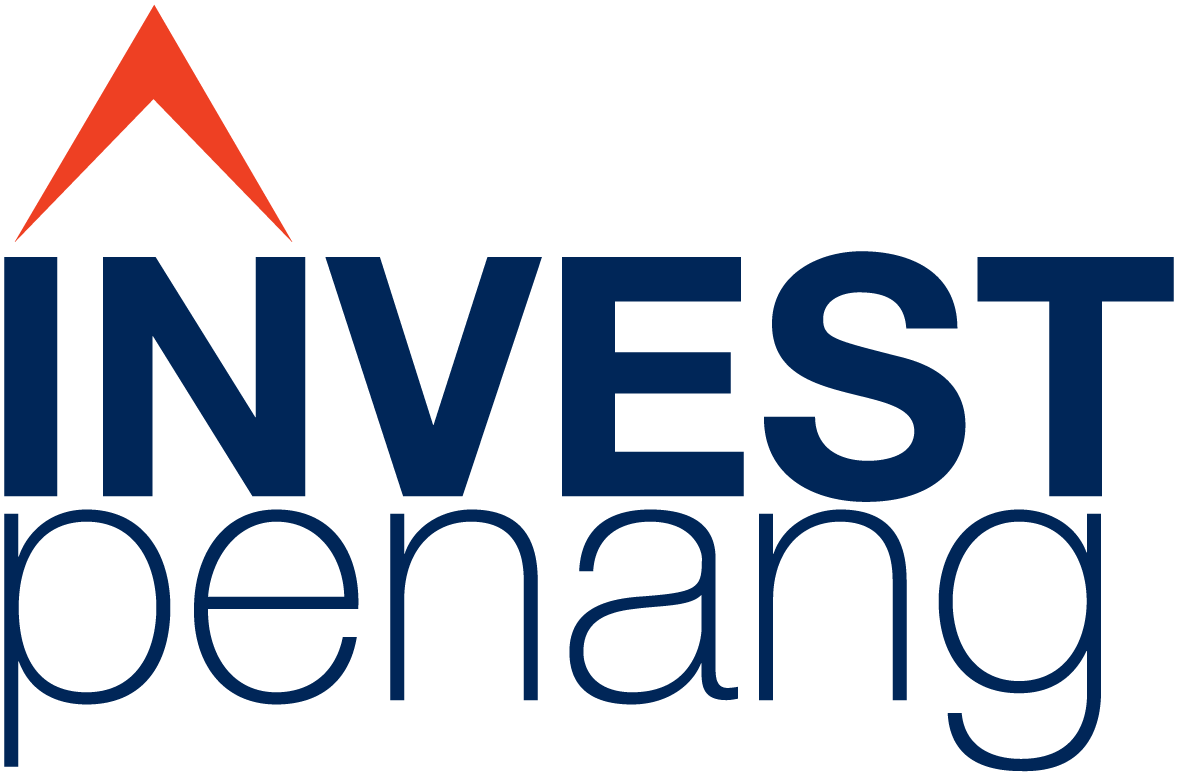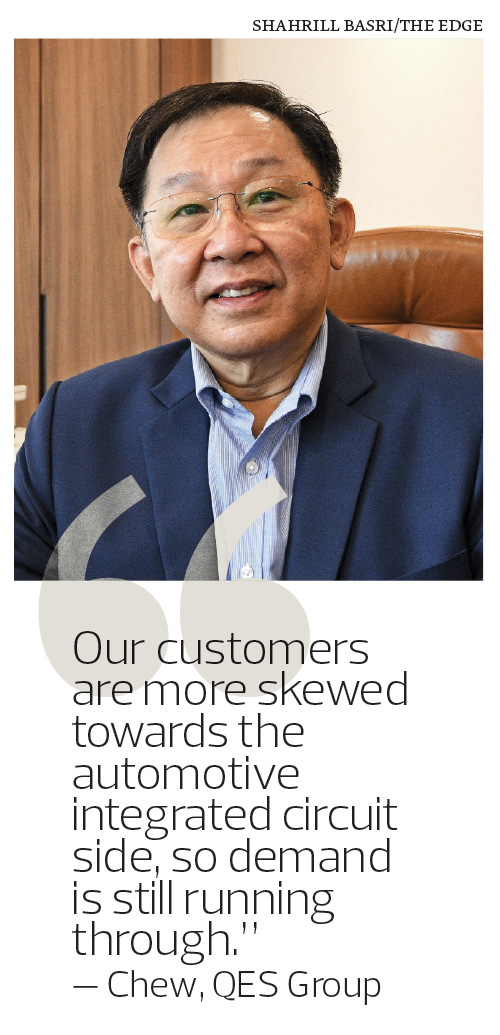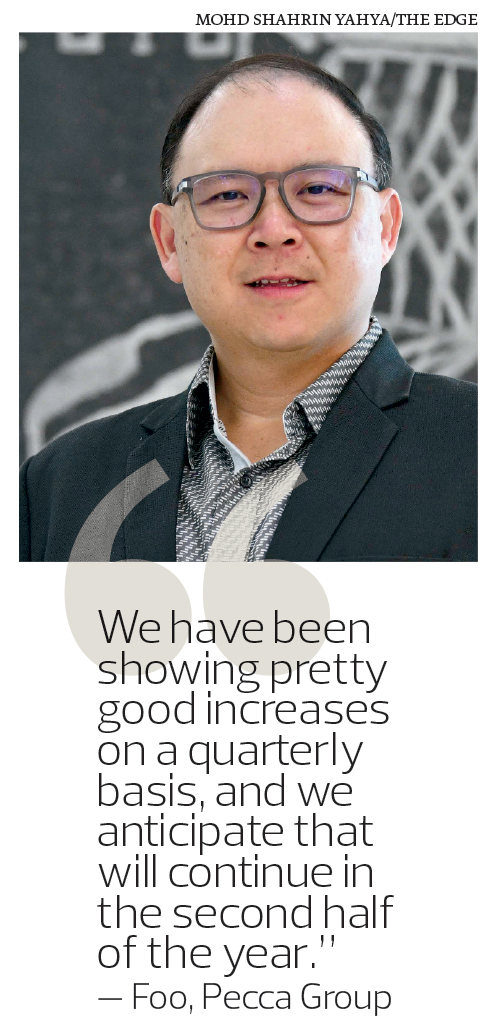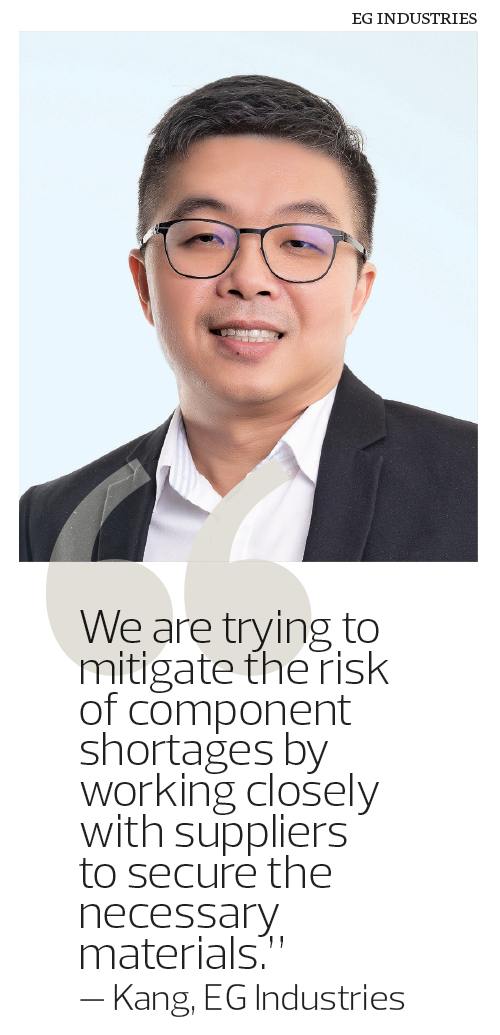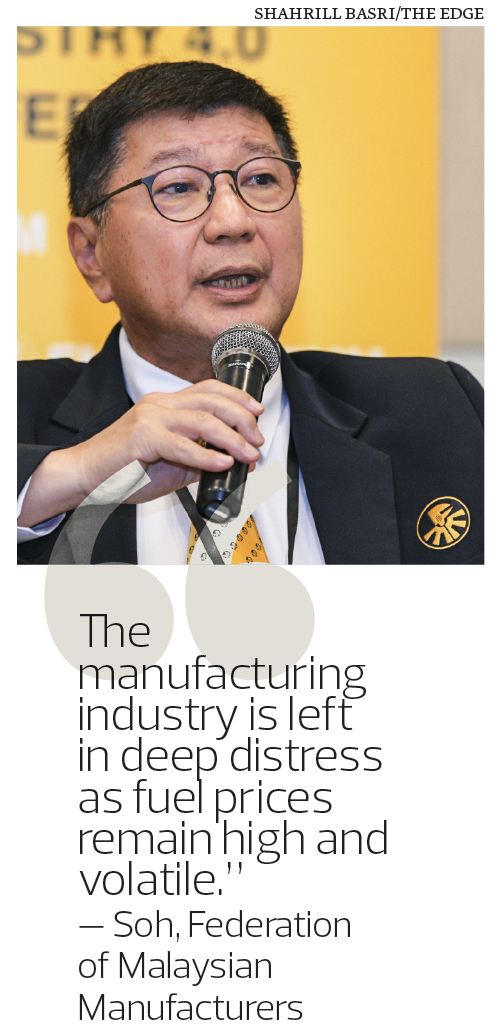
The State of the Nation: What Firms Say of Their Sales Amid Moderation in Manufacturing PMI


April 17, 2023 – MALAYSIA’s manufacturing sector, having moderated further at the end of the first quarter of this year, is at risk of experiencing a downturn because of global economic uncertainties, notwithstanding indications that demand is on the increase.
The S&P Global manufacturing Purchasing Managers’ Index (PMI) has been hovering below the 50-point level since August 2022, with the latest reading at 48.8 in March compared with 48.4 in February.
Manufacturing sales of RM148 billion in January, while a 6.5% rise year on year, were in fact the lowest since May 2022, according to the Department of Statistics Malaysia.
In fact, companies such as ECA Integrated Solution Bhd — an automated manufacturing solutions provider — are feeling the heat from the risk of global recession as some customers are now planning to hold back on capital expenditure, while others have requested a delay in the delivery of orders.
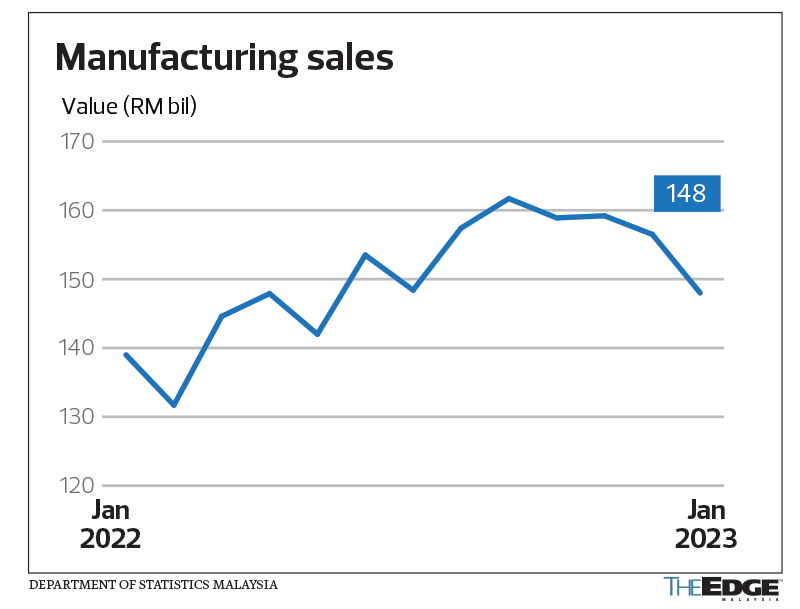

PublicInvest Research is cautious about the immediate future of the manufacturing industry due to the preponderance of risks that tilt towards the downside, including elevated levels of inflationary pressure and interest rates, along with persisting geopolitical conflicts.
“Our projection indicates that the manufacturing industry as a whole will experience a 4.4% expansion in 2023, surpassing Bank Negara Malaysia’s official forecast of 4%,” the research house said in an April 4 note.
Bank Negara expects export growth to ease significantly to only 1.5% in 2023 after two consecutive years of double-digit growth, according to the central bank’s Economic and Monetary Review 2022 report published recently. This is in line with a weaker global growth outlook, especially for the country’s key trade partners among the advanced economies.
According to the Federation of Malaysian Manufacturers (FMM) Business Conditions Survey 2H2022 conducted from Jan 18 to Feb 28, its members expect sales to slow down in the first six months of 2023. Local sales, however, are expected to be ahead of export sales based on the index for local and export sales.
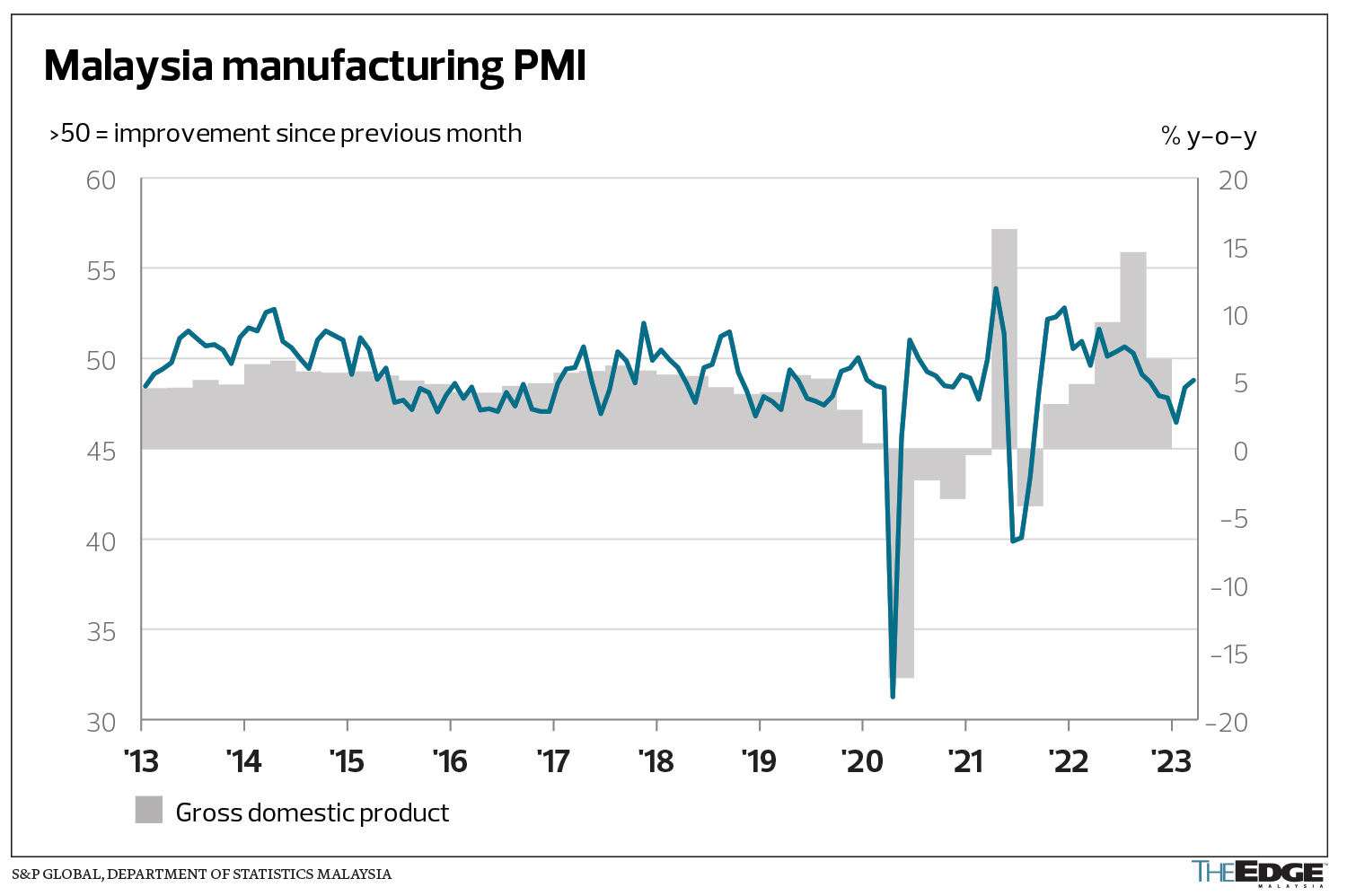

S&P Global says the latest manufacturing PMI reading points to the least marked slowdown in business conditions since last September. “The latest PMI reading is also consistent with sustained, solid expansions in both manufacturing production and GDP (gross domestic product), with signs that growth has picked up since the start of the year,” it says in an April 3 note.
“In line with the headline figure, there were signs that the lull in demand was easing during March, with order book volumes reducing at a slower rate. The moderation was only mild and the softest seen since last October.
“While a number of firms still noted that client confidence was subdued, some commented that demand had shown signs of recovery at the end of the first quarter through an increase in customer orders. Similarly, there was a slower reduction in new export orders, which fell at the softest pace since July 2022.”
Business leaders of manufacturing firms whom The Edge spoke to agree as they think the business outlook may not be that gloomy. They say their sales are still holding well and they are continuing with their expansion plans to cater for future needs.
Some players observe that customers have turned more cautious in putting in their orders and stress that the ability to secure new orders is crucial to get through the current challenging business environment.
QES Group Bhd managing director and president Chew Ne Weng says that while there could be a slowdown in the general manufacturing segment on the back of reduced spending power — especially in fast-moving consumer goods — the company saw a surge in sales in March.
“January was a slow month because of the year-end holiday and the Chinese New Year, then February was a short month. Suddenly, we saw a big jump in sales for March, hitting RM30 million in that month alone. Our customers are more skewed towards the automotive integrated circuit side, so demand is still running through,” he adds.
QES, which distributes and manufactures automated test equipment, had an order book of RM106 million in February, of which RM21 million was from the manufacturing segment and RM85 million from the distribution segment.
“It was not too bad or too good. Year on year, it was slightly higher than last year. We have a certain level of sustainability. We hope to be able to bill all these orders in the next four to eight months,” says Chew.
Despite the market uncertainties, QES will continue to invest in the expansion of its plants, he adds. “We’re not really affected by that, unless there is a major event like the collapse of Lehman Brothers in 2008.”
The company has budgeted about RM25 million for the expansion of its plant in Batu Kawan, Penang.
Pecca Group Bhd CEO Foo Ken Nee believes the company’s sales will continue to grow, even though the Malaysian Automotive Association (MAA) forecast that total industry volume would decline 9.8% in 2023 after surpassing the 700,000 mark in 2022.
“We have been showing pretty good increases on a quarterly basis. We anticipate that will continue in the second half of the year,” he says.
“From our perspective, I think the main concern is how to maintain the growth over the longer term. Perodua is one of our biggest customers and it is committed to expanding its production. The question is whether we can meet all of its requirements. We believe we can.”
For the first half of its financial year ended Dec 31, 2022, Pecca’s net profit more than doubled to RM16.76 million from RM6.52 million in the previous corresponding period. Its other major customers include Mitsubishi, Toyota and Nissan.
“We continue to receive enquiries from existing and new customers. I think even if there’s a little bit of slowdown, it is not a concern at all. Right now, we’re in discussions with a few new potential customers. Although an economic slowdown may affect some of our existing customers, having new customers can mitigate this negative effect,” he tells The Edge.
That is because some of its customers have turned more cautious in terms of orders. Nevertheless, PIE has allocated RM60 million for the expansion of its plants, one of which is expected to be operational by this year.
“We’re at a very interesting time. We believe the EMS (electronic manufacturing services) industry will hold well for the next few years,” says Mui.
Another EMS firm, EG Industries Bhd, is seeing a pickup in orders from clients involved in 5G-related products, following a slowdown in orders for data storage devices since mid-2022. Its CEO Datuk Alex Kang says the company is moving upstream and ramping up on orders, especially for 5G-related products that its US-based R&D and manufacturing firm Cambridge Industries Group produces, like advanced high-speed optical signal transmitters and receivers for the 5G wireless network using photonics and semiconductor technologies.
EG Industries serves industries such as consumer electronics, information and communications technology, medical, automotive and telecommunications. Operationally, the company will continue to focus on improving efficiency, he says.
“This includes alternative sourcing and more automation, so that we have more consistent quality and achieve higher revenue per employee. We are also trying to mitigate the risk of component shortages by working closely with suppliers to secure the necessary materials,” he adds.
The company’s expansion plans include the setting up of a RM180 million smart “lights out” factory 4.0 in Batu Kawan, Penang, which is expected to be completed in the first half of 2024.
It is also building smart warehouses and an international procurement centre featuring Kedah’s first vendor management inventory system to serve its own increasing requirements as well as that of the surrounding industrial cluster in Sungai Petani in Kedah and Batu Kawan in Penang. The RM40 million facilities are slated for completion in 2024.
In the first half of its financial year ended Dec 31, 2022, EG Industries’ net profit jumped 84.4% to RM18.17 million from RM9.86 million in the previous corresponding period.
“We hope to keep up the momentum, barring any unforeseen circumstances like rising interest and inflation rates, increase in the minimum wage and the ongoing US-China trade war,” says Kang.
Furniture players may be finding the situation more challenging. Take office furniture maker Euro Holdings Bhd. Its deputy managing director Datuk Kenix Lim Sze Way sees a slowdown in orders, especially from foreign markets. Exports account for 30% to 40% of the company’s total sales.
Due to the tough operating landscape, she understands that some furniture players in Muar, Johor, have ceased operations. On the bright side, she says local furniture orders remain resilient, driven by economic recovery and a pick-up in business activity.
However, Euro’s business operations have been impacted by the relocation of its plant from Rawang in Selangor to Melaka, which prompted the company to stop taking orders for the time being.
For the 12 months ended Dec 31, 2022, Euro — which is also involved in the property sector — posted a narrower net loss of RM12.21 million from RM21.74 million in the previous year. Its bottom line was partly affected by the provision for liquidated ascertained damages due to a delay in the issuance of certificate of completion and compliance for a property project. Its financial year end was recently changed to June 30 from Dec 31.
Lim says raw materials such as steel are less of a concern after the easing of the global commodity boom.
Effect of higher electricity prices
On increased electricity cost, QES’ Chew says it is still manageable for the company, which is not in the high usage band. But he adds that the hike has impacted its customers.
“I got feedback from our customers, who are big multinational corporations, that they have been impacted by this. In order to remain competitive, Malaysia needs to be at least comparable with its regional peers such as Thailand, Vietnam, Indonesia and the Philippines,” he remarks.
An upward adjustment in the electricity tariff for large corporations came into effect on Jan 23, resulting in a 40% surge in electricity cost for affected businesses.
Other risks that Chew foresees are higher interest rates, which will have a severe impact on Malaysia’s economy, as well as oil production cuts by the Organization of the Petroleum Exporting Countries (Opec). “It was a surprise because a lot of people did not expect Opec to make such a sudden move,” he says.
Pecca’s Foo believes that the hike in electricity tariff can be managed. In the company’s case, it does not consume too much electricity given the installed cooling system at its plant.
For PIE, the high electricity issue is expected to be resolved when it completes the installation of solar panels at its plant in Penang by the fourth quarter of this year. “We’re installing the maximum 70% capacity, and we have to buy the remaining 30% from Tenaga Nasional Bhd,” says Mui.
On currency movements, he highlights that PIE incurred quite a substantial foreign exchange loss towards the end of last year, when the ringgit sharply appreciated against the greenback, because a lot of its earnings are denominated in the US dollar.
“We undertook a natural hedge. It didn’t work well for us, hence the big exchange loss. But we think this type of scenario will not happen very often, and we believe the US dollar will continue to hold strong for quite a while. Then, it will be advantageous to us,” says Mui.
Meanwhile, the labour shortage continues to be an issue for EG Industries despite the reopening of borders. “All industries need to fill their manpower gap. This has created an inflationary effect, especially for skilled workers,” says Kang.
FMM president Tan Sri Soh Thian Lai tells The Edge that the current elevated energy cost is the main concern for manufacturers, which is the second top risk to business recovery and growth in 2023.
“In terms of electricity cost, given the diverse consumption, load profiles, connection levels and nature of businesses among Malaysian industries, the energy cost could range between 1% and more than 10% for the energy-intensive industries,” he says.
“As there are no signs that the conflict in Eastern Europe will subside in the near future, the industry is left in deep distress as fuel prices remain high and volatile, especially for manufacturers that depend on natural gas purchased at market price for their production.”
As such, Soh calls on the government to implement a phased, gradual increase in surcharge to minimise the cost impact on the supply chain, including the end customers, as the business environment continues to be challenging.
Also, he wants temporary measures and assistance to help companies that have been severely affected by the imbalance cost pass-through surcharge and missed out on the green electricity tariff due to the limited quota, by introducing an easy payment plan for medium- and high-voltage customers as well as facilitating a free or minimal energy audit fee for these customers.
Another suggestion is for the government to consider providing a tax credit for the significant natural gas cost incurred in the previous year due to the global conflict.
Source: The Edge Markets
